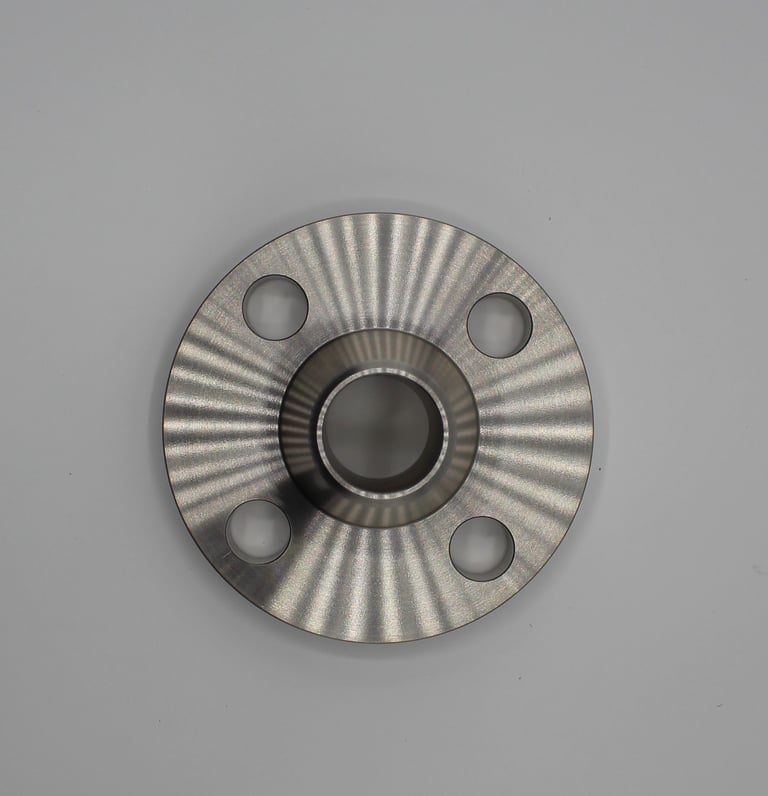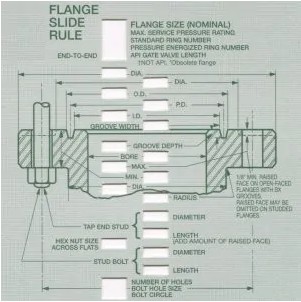API Flange
Manufacturing and supplying a complete line of flanges with multiple material grades available.


Rated 4.8/5
★★★★★
About API Flange
API flange is a pipe flange manufactured to the American Petroleum Institute (API) specifications. Managing high-pressure and high-temperature conditions in industrial applications must be taken seriously. When it comes to ensuring the integrity and safety of your piping systems, API flanges play a pivotal role. This article will explore the API flange and offer a complete solution to understanding their dimensions, sizes, and reputable manufacturers.






Understanding API Flange
API flanges are a fundamental component in the industrial world, especially in environments with high pressure and temperatures. Their primary role is to connect pipes, valves, and other equipment, creating a secure and leak-free seal. These are essential for the safety and reliability of operations in various industries, such as oil and gas, petrochemicals, and power generation.
API flanges are important because they provide a reliable and secure way to connect pipes and other fittings. They are also designed to withstand high pressures and temperatures, making them ideal for critical applications.
Types of API Flange:
Weld neck flanges: Weld neck flanges are the most common type of API flange. They are strong, reliable, and can withstand high pressures and temperatures.
Blind flanges: Blind flanges close off the end of a pipe or fitting. They are typically used for maintenance or isolation purposes.
Threaded flanges: Threaded flanges are the least common type of API flange. They are typically used in low-pressure applications where ease of installation is important.
Explore our products
Provide a short description of categories listed below.
API Flange Dimensions and Sizes






API flange dimensions and sizes are not one-size-fits-all. Different applications and industries require specific dimensions to handle varying pressure and temperature levels. The dimensions are standardized to ensure compatibility and safety across the board. These standards cover a wide range of sizes, so selecting the right one for your project is crucial to ensure the system’s efficiency and safety.
API Slide Rule
API slide rules are practical tools for making informed decisions when selecting API flanges. API slide rules, a handy tool for engineers and professionals, are crucial in simplifying the complex process of selecting the right API flange for a specific project. These tools are ideal for engineers and professionals seeking efficient solutions for their piping systems. They work with API flange charts to simplify the selection process, making it quick and accurate.
API Flange Manufacturers
Not all API flange manufacturers are created equal. Selecting the right manufacturer is crucial. Reliable API flange manufacturers adhere to strict quality standards, ensuring that the flanges they produce meet the highest industry benchmarks. By choosing a reputable manufacturer, you can have confidence in the performance and safety of your API flanges. The next sections will also delve into specialized API flanges, such as the API 10000 flange, and their specific dimensions and applications. Stay with us as we explore this world of high-pressure solutions.


Image Source: Texas Flange
Explore our products
Provide a short description of categories listed below.
API 10000 Flange Dimensions






API 10000 flanges are designed to handle extreme pressure, making them essential in industries under these harsh conditions. These flanges are engineered to meet specific dimensions, allowing them to withstand pressures others cannot. Understanding the dimensions of API 10000 flanges is crucial when dealing with applications where safety and reliability are paramount.
How to Choose the Right API Flange Size
When choosing the right API flange size, you need to consider the following factors:
The pressure rating of the flange: You must choose a flange with a pressure rating greater than or equal to the system’s operating pressure.
The temperature rating of the flange: You need to choose a flange with a temperature rating greater than or equal to the system’s operating temperature.
The pipe size: You must choose a flange the same size as the pipe it attaches to.
Applications of API flange
Oil and gas industry: API flanges are used in the oil and gas industry for various applications, including wellheads, drilling equipment, pipelines, and processing facilities.
Petrochemical industry: API flanges are used in the petrochemical industry for various applications, including pipelines, processing vessels, and reactors.
Power generation industry: API flanges are used in the power generation industry for various applications, including boilers, turbines, and piping systems.
Other industries: API flanges are also used in various other industries, including food and beverage processing, chemical processing, and water and wastewater treatment.
Installation and Maintenance of API Flange
Installation:
Prepare the flange faces. The flange should be clean and free of any debris. If the flange faces are corroded, they should be cleaned using a wire brush or other abrasive tool.
Apply a gasket. A gasket should be placed between the two flanges. The gasket should be made of a material compatible with the fluid being transported and rated for the system’s pressure and temperature.
Install the bolts or studs. The bolts or studs should be tightened in a star pattern to ensure the flange is evenly loaded.
Torque the bolts or studs. The bolts or studs should be torqued to the manufacturer’s specifications.
Maintenance:
Inspect the flange faces for signs of corrosion or wear: The flange should be repaired or replaced if any corrosion or wear is found.
Inspect the gasket for signs of damage or leakage: It should be replaced if it is damaged or leaking.
Check the torque on the bolts or studs: The bolts or studs should be torqued to the manufacturer’s specifications.
FAQs
Q: What is the main function of API flanges in high-pressure applications?
API Flanges are critical in connecting pipes, valves, and equipment in high-pressure environments to create a secure and leak-free seal. These are essential for maintaining the integrity and safety of industrial processes.
Q: How are API flanges different from standard flanges?
API flanges are designed to handle high-pressure and high-temperature conditions, making them suitable for industries where safety and reliability are paramount. Standard flanges may not have the same pressure and temperature ratings.
Q: Are API flange dimensions standardized, and why is that important?
Yes, API flange dimensions are standardized to ensure compatibility and safety. Standardization allows engineers and professionals to select the right flange for their specific applications, reducing the risk of errors and enhancing system safety.
Q: How do API flange charts and slide rules simplify selection?
API flange charts and slide rules provide a visual and simplified way to match the right flange with specific project requirements. They consider factors like pressure, temperature, and pipe size, making it easier to choose the appropriate flange.
Q: What should I look for in a reliable API flange manufacture?
A reliable manufacture should adhere to industry standards, use high-quality materials, and have a record of producing quality products.
Q: What industries typically require API 10000 flanges?
API 10000 flanges are commonly used in industries with extreme high-pressure conditions, such as deep-sea oil drilling, high-pressure gas applications, and certain chemical processes.
Q: Can API flanges be used in various industrial applications?
Yes, API flanges are versatile and find application in various industries, including oil and gas, petrochemicals, power generation, and more.
Conclusion:
In conclusion, this comprehensive guide has deeply understood API flanges. It covers their significance in high-pressure environments, dimensions, sizes, reliable manufacturers, and specialized variations like the API 10000 flange. We’ve emphasized the importance of proper selection, installation, and maintenance while highlighting the safety and reliability of these critical components. for more info visit: https://en.wikipedia.org/wiki/Flange
For all your flange steel requirements, consult with reputable manufacturers and suppliers like Texas Flange, who can provide the right flange solutions tailored to your application’s demands.
Privacy Policy
Welcome to API Flange! Your privacy is important to us. This Privacy Policy explains how API Flange we collects, uses, discloses, and safeguards your information when you visit our website www.apiflange.com. By using our Site, you agree to the terms of this Privacy Policy.
Privacy Policy
1. Information We Collect
We may collect various types of information, including:
Personal Information: Information that can identify you personally, such as your name, email address, phone number, and mailing address, which you provide when you contact us or request a quote.
Non-Personal Information: Information that does not directly identify you, such as your browser type, operating system, IP address, and browsing behavior on our Site.
Cookies and Tracking Technologies: We use cookies and similar tracking technologies to enhance your experience, analyze Site usage, and personalize content.
2. How We Use Your Information
We use the information we collect for purposes including:
Providing and Improving Services: To operate and improve our Site and services, respond to your inquiries, and provide customer support.
Communicating with You: To send you updates, promotional materials, and other information related to our products and services.
Analyzing and Personalizing: To understand how you use our Site and to personalize your experience.
3. Sharing Your Information
We may share your information under the following circumstances:
Service Providers: With third-party service providers who assist us in operating our Site and providing our services.
Legal Obligations: When required by law or to comply with legal processes.
Business Transfers: In the event of a merger, acquisition, or sale of all or a portion of our assets, your information may be transferred to the new owner.
4. Security of Your Information
We implement reasonable security measures to protect your information from unauthorized access, use, or disclosure. However, no method of transmission over the internet or electronic storage is completely secure. Therefore, we cannot guarantee absolute security.
5. Your Choices
You have certain choices regarding the information we collect and how it is used:
Access and Update: You can access and update your personal information by contacting us directly.
Opt-Out: You can opt-out of receiving promotional emails by following the unsubscribe instructions in those emails.
Cookies: You can manage your cookie preferences through your browser settings.
6. Children’s Privacy
Our Site is not intended for children under 13. We do not knowingly collect personal information from children under 13. If we become aware that we have collected personal information from a child under 13, we will take steps to delete such information.
7. Changes to This Privacy Policy
We may update this Privacy Policy from time to time. We will notify you of any changes by posting the new Privacy Policy on our Site and updating the effective date. Your continued use of the Site after such changes constitutes your acceptance of the revised Privacy Policy.
8. Contact Us
If you have any questions or concerns about this Privacy Policy or our privacy practices, please contact us at:
API Flange
Email: sales@texasflange.com
Phone: 281-484-8325
Address: P.O. Box 2889 Pearland, TX 77588
Thank you for trusting API Flange with your information. We value your privacy and are committed to protecting it.
Gallery
A glimpse into our precision flange craftsmanship










Contact
Email: sales@texasflange.com
Phone: 281-484-8325
Address: P.O. Box 2889 Pearland, TX 77588
© 2025. All rights reserved.